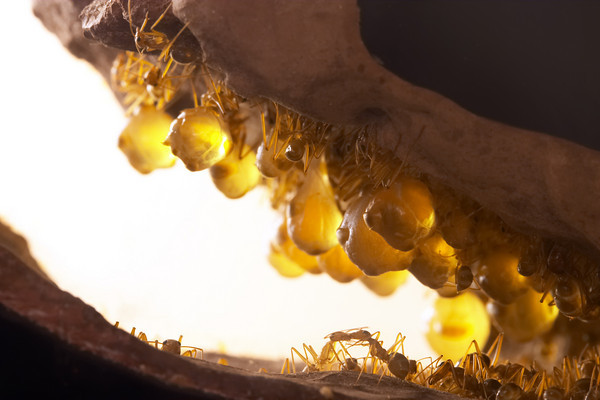
If I’ve learned anything as a science writer, it’s that scientists produce such a flood of fantastically odd factoids that boredom isn’t much of an occupational hazard. Heck, the chances that deep boredom will strike during work are right down there with the odds a cataclysmic disaster will obliterate humanity come 2012. (Pretty much impossible, in other words.)
I got a healthy reminder of this last week when a bug expert—an entomologist, in proper scientific parlance—by the name of Benoit Guenard turned me on to some photos of a truly bizarre genus of ant called Myrmecocystus. A slice of one of those photos—a group of jaw-droppingly obese honeypot ants hanging from the roof of a nest—became our most recent “What On Earth is That?”
This particular type of ant, which lives in deserts, is like something out of The Matrix. When food is plentiful, honeypot colonies select certain workers—entomologists call them repletes—to serve as food receptacles for the group. The other workers tuck the repletes away in a safe spot, and then literally stuff them with food until the back sections of the repletes literally swell up like water balloons.
Grape-sized repletes so fat they cannot walk are common. When food gets short, hungry workers just wander over to a replete, poke and prod it a bit, and wait for it to upchuck lunch. If that’s not bizarre enough, it turns out that rival honeypot ant colonies have a habit of raiding one another and plundering–then enslaving–repletes. Stranger yet, it’s not just ants that have a taste for repletes; they’re something of a local delicacy among certain tribes in Australia.
Nobody knows the total number of ant genera in the world, or species for that matter, Guenard tells me, since biologists have never managed to cobble together a systematic search at the scale required. That’s not for lack of effort. In the nineties, an ambitious effort to name every single species on Earth (not just ants but all species) in a mere 25 years—the equivalent of a Moon shot for taxonomists–flamed out when the tech bubble burst and the project lost its funding. Other efforts to classify smaller bits of ecological real estate have suffered similar fates.
Still, there are biologists out there like Guenard doing their best to continue counting. Guenard, a graduate student at the University of North Carolina, participates in the Global Ant Diversity Project, an effort led by his adviser Rob Dunn and sponsored, in part, by NASA. (I first met Dunn at a NASA-sponsored Ecological Forecasting conference where he was explaining how he uses satellite data to predict global patterns of ant diversity. Check out this PowerPoint if you want to learn more about how that works).
Guenard updates the growing ant database as new information turns up in the scientific literature, but he also keeps an astonishing website and blog that brims with eye-popping photography and commentary about ant species that I’m willing to bet you never knew existed. Take a look, for example, at these Pachycondyla chinensis doing battle with some hapless-looking termites. Or look at this pint-sized worker intimidating a hermit crab dozens of times its size.
–Adam Voiland, NASA’s Earth Science News Team

truly awesome!
8801631227
Why NASA does not have a button I LOVE NASA in Facebook and Twitter? I do love Nasa because it is for me the most important scientific institution worldwide.